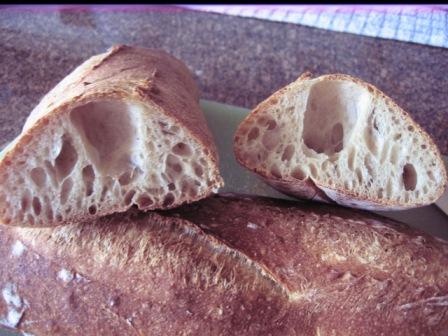
Hamelman's Pain au Levain
Today I baked loaves of the pain au levain that we created in the French bread workshop at KAF. The recipe we followed there varies slightly from those found in Hamelman's Bread in that no rye flour is involved. The baking temperature is also lower - 220° C versus the 240° C in his book.


I also scaled this to produce two 500g batards:
Overall formula
500g sir galahad (or KAF's AP) flour (85%)
88g whole wheat flour (15%)
400g water (68%)
11g salt (1.8%)
First build
11g sir galahad
4g whole wheat
9g water
3g culture (I maintain my starter at 60% hydration)
The first build should take place approximately 30 hours before the bake.
Levain
52g sir galahad
8g whole wheat
36g water
27g first build
The second build is mixed approximately 18 hours before the bake.
Final dough
437g sir galahad
76g whole wheat
355g water
11g salt
120g levain (this is the weight of the levain after backing out the 3g of original culture, although given the small amount I left it in)
The final dough mix occurs approximately 6 hours before the bake. Desired dough temperature is 76-78° F.
Mix ingredients except for the salt and levain until they just come together. Autolyse the flour and water mixture for 20 - 30 minutes. Add the salt and chunks of levain and mix on second speed until moderately developed - with a stand mixer this took me about 5 minutes.
Dough undergoes a bulk fermentation of 2 - 2.5 hour with two folds. I went for 2.5 hours with folds at 60 minute intervals.
Divide into two equal pieces of dough, lightly round and bench rest for 20-30 minutes.
Shape into batards and allow a final fermentation of 1.5 - 2 hours. I placed my batards seam side up on a well-floured couche.
Score, load into preheated oven to 220°, steam and bake approximately 35 - 40 minutes. If using an unvented oven, crack the door slightly once the dough begins to show color. (I misted both batards before placing them in the oven, and then misted them twice again at 2 minute intervals and I think it helped my cuts remain moist enough to open during the bake).

The end product was two 13oz loaves. I'm pleased with the outcome. My slashes opened moderately - these are about the best gringes I've produced. And the crumb shows good oven spring as well.
Oh - and being lazy and cheap, here's the flipper board I used to move them from my Home Depot couche (kudos to Eric and others who pointed out that a painters drop cloth is basically a couche - but so much cheaper!!) to my baking stone:

Yes, if you look carefully you'll see that it's actually the serated cutting insert to a box of food service wrap. Completely jury-rigged, but it works!
I like this particular bread! Good for basic sandwich use and especially with a good cheese or tapenade.
Larry


David
Thank you David!
Wow Larry what a beautiful job you did on these! The flipper board is brilliant, lol.
It looks like you have found a way to duplicate the commercial bakery at home. Thanks for sharing.
Eric
Eric-
I thought you'd get a kick out of that. I have to say, though, the painters cloth works brilliantly!
Now, back to my nemesis, the baguette gringes...
Larry
I love Hamelman. afetr i'll master the simple breads i'm gonna move to this higher class.
and that bread is higher class indeed. i like it
Ron
Thanks Ron! Jeffrey and James MacGuire are wonderful teachers who inspire!
Larry